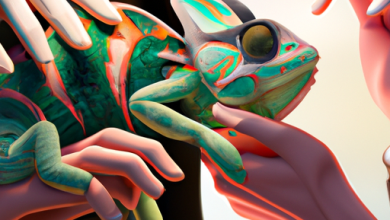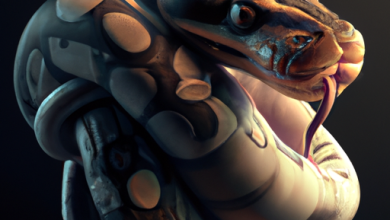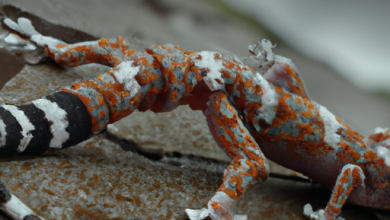Bearded Dragon: Species Profile

Bearded Dragon Natural Habitat: An Overview of the Species’ Preferred Environment
The Bearded Dragon (Pogona vitticeps) is a species of agamid lizard native to. This species is popular pet trade due to its nature and hardy constitution such, it is important the natural habitat ofarded Dragon in order to care for captive specimens.The Bearded Dragon is throughout Australia, inhabiting a wide range of habitats including deserts, woodlands, and grasslands. In these habitats, they are often found basking on rocks and logs, or hiding in crevices and under vegetation. They prefer areas with plenty of basking spots, as well as access to food and water sources.
Bearded Dragons are diurnal animals, meaning they are active during the day and sleep at night. During the day, they can be found basking in the sun to regulate their body temperature. They also enjoy spending time in cooler areas, such as burrows or crevices, to avoid overheating.
Bearded Dragons are omnivorous animals, meaning they feed on both plants and animals. Their diet consists of insects, fruits, vegetables, and small rodents. In the wild, they will also scavenge for carrion when available.
Bearded Dragons prefer habitats with plenty of vegetation for cover and food sources. They are also drawn to areas with plenty of rocks and logs for basking spots. They are often found near bodies of water
Bearded Dragon Care: A Guide to Properly Maintaining Your Pet
Bearded dragons are one of the most popular pet reptiles, and for good reason. These friendly lizards are relatively easy to care for, and can provide years of companionship and entertainment. However, like all animals, they require proper maintenance to stay healthy and happy. This guide will provide you with all the information you need to properly care for your bearded dragon.
First, you will need to provide your bearded dragon with a suitable habitat. Bearded dragons are native to Australia, so they prefer warm, dry climates. A large terrarium with a screen lid is ideal for housing your pet. You should provide a basking spot with a temperature of 95-105°F, as well as a cooler area of the terrarium with a temperature of 75-85°F. You should also include a shallow water dish and plenty of hiding places.
Second, you will need to feed your bearded dragon a balanced diet. Bearded dragons are omnivores, so they require both animal and plant-based foods. A good diet for your pet should include crickets, mealworms, waxworms, and other insects, as well as dark leafy greens such as kale and collard greens. You should also provide occasional treats such as fruits and vegetables.
Third, you will need to provide your bearded dragon with the proper lighting and UVB exposure. Bearded dragons require full-spectrum lighting that mimics natural sunlight. This should include both UVA and
Bearded Dragon Diet: Tips for Feeding Your Reptile
Bearded dragons are an increasingly popular pet reptile, and for good reason. They are relatively easy to care for and can make wonderful companions. One of the most important aspects of keeping a healthy bearded dragon is providing them with a proper diet. It is important to understand the dietary needs of your pet in order to ensure its health and wellbeing.
Bearded dragons are omnivores, meaning they eat both plant and animal matter. A balanced diet should include a variety of fresh fruits and vegetables, as well as insects such as crickets, mealworms, and waxworms. The size of the insects should be appropriate for the size of your dragon, with smaller insects for younger dragons and larger insects for older dragons. It is important to feed your dragon a variety of insects in order to provide a balanced diet.
In addition to insects, bearded dragons also need a source of calcium in their diet. This can be provided through the use of commercially available calcium supplements or by feeding them calcium-rich foods such as kale and collard greens. It is important to dust the insects with calcium powder prior to feeding them to your dragon in order to ensure they are getting enough calcium.
It is also important to provide your bearded dragon with a source of vitamin D3. This can be provided through the use of a UVB light, which should be on for 12-14 hours per day. Without this light, your dragon will not be able to absorb the calcium in their
Bearded Dragon Health: Recognizing Common Illnesses and Diseases
Bearded dragons are a popular pet choice for reptile enthusiasts due to their docile nature and ease of care. However, like all animals, bearded dragons are susceptible to illnesses and diseases. It is important for owners to be aware of the signs and symptoms of common illnesses and diseases in order to provide the best care for their pet.
The most common illness in bearded dragons is Metabolic Bone Disease (MBD). MBD is caused by a lack of calcium in the diet, leading to weakened bones and soft tissue. Symptoms of MBD include softening of the bones, lethargy, twitching, and loss of appetite. If left untreated, MBD can lead to death. To prevent MBD, owners should ensure their bearded dragon has a balanced diet with plenty of calcium-rich foods.
Another common illness in bearded dragons is Respiratory Infection (RI). RI is caused by a bacterial or viral infection of the respiratory system. Symptoms of RI include wheezing, coughing, and discharge from the nose or mouth. If left untreated, RI can lead to death. To prevent RI, owners should ensure their bearded dragon’s enclosure is kept clean and free of any potential sources of infection.
In addition to MBD and RI, bearded dragons are also susceptible to parasites. Parasites can cause a variety of symptoms including weight loss, diarrhea, lethargy, and loss of appetite. To prevent parasites, owners should ensure their bearded
Bearded Dragon Behavior: Understanding Your Pet’s Natural Instincts
Bearded dragons are a popular pet choice for many reptile enthusiasts. These fascinating creatures are relatively easy to care for and have a unique personality that makes them a joy to observe. However, it is important to understand your pet’s natural behavior in order to ensure that they are happy and healthy.
Bearded dragons are social animals and enjoy interacting with their owners. They can be handled gently and often enjoy being petted. They tend to be active during the day, and will often bask in the sunlight to regulate their body temperature. When they are not active, they will usually sleep or rest in a cool, dark area.
Bearded dragons are omnivorous, meaning they will eat both plant and animal matter. Their diet should include a variety of vegetables, fruits, insects, and occasional small amounts of meat. It is important to provide a balanced diet with the right amount of vitamins and minerals to ensure your dragon remains healthy.
Bearded dragons are territorial animals and may become aggressive if they feel threatened. They may also become aggressive if they feel their territory is being invaded by another dragon or other animal. If you have multiple dragons, it is important to provide them with enough space so that they can establish their own territories without conflict.
Bearded dragons are also known for their curiosity. They will often explore their environment, which can include anything from furniture to plants to other pets. It is important to provide them with plenty of space to explore
Excerpt
The Bearded Dragon (Pogona vitticeps) is a medium-sized, diurnal lizard native to Australia. It is an omnivorous species, and will feed on a variety of insects, vegetables, and fruits. In captivity, they can reach up to 24 inches in length. They are hardy and easy to care for, making them popular pets among reptile enthusiasts.
Bearded Dragon Natural Habitat: An Overview of the Species’ Preferred Environment
The Bearded Dragon (Pogona vitticeps) is a species of agamid lizard native to. This species is popular pet trade due to its nature and hardy constitution such, it is important the natural habitat ofarded Dragon in order to care for captive specimens.The Bearded Dragon is throughout Australia, inhabiting a wide range of habitats including deserts, woodlands, and grasslands. In these habitats, they are often found basking on rocks and logs, or hiding in crevices and under vegetation. They prefer areas with plenty of basking spots, as well as access to food and water sources.
Bearded Dragons are diurnal animals, meaning they are active during the day and sleep at night. During the day, they can be found basking in the sun to regulate their body temperature. They also enjoy spending time in cooler areas, such as burrows or crevices, to avoid overheating.
Bearded Dragons are omnivorous animals, meaning they feed on both plants and animals. Their diet consists of insects, fruits, vegetables, and small rodents. In the wild, they will also scavenge for carrion when available.
Bearded Dragons prefer habitats with plenty of vegetation for cover and food sources. They are also drawn to areas with plenty of rocks and logs for basking spots. They are often found near bodies of water
Bearded Dragon Care: A Guide to Properly Maintaining Your Pet
Bearded dragons are one of the most popular pet reptiles, and for good reason. These friendly lizards are relatively easy to care for, and can provide years of companionship and entertainment. However, like all animals, they require proper maintenance to stay healthy and happy. This guide will provide you with all the information you need to properly care for your bearded dragon.
First, you will need to provide your bearded dragon with a suitable habitat. Bearded dragons are native to Australia, so they prefer warm, dry climates. A large terrarium with a screen lid is ideal for housing your pet. You should provide a basking spot with a temperature of 95-105°F, as well as a cooler area of the terrarium with a temperature of 75-85°F. You should also include a shallow water dish and plenty of hiding places.
Second, you will need to feed your bearded dragon a balanced diet. Bearded dragons are omnivores, so they require both animal and plant-based foods. A good diet for your pet should include crickets, mealworms, waxworms, and other insects, as well as dark leafy greens such as kale and collard greens. You should also provide occasional treats such as fruits and vegetables.
Third, you will need to provide your bearded dragon with the proper lighting and UVB exposure. Bearded dragons require full-spectrum lighting that mimics natural sunlight. This should include both UVA and
Bearded Dragon Diet: Tips for Feeding Your Reptile
Bearded dragons are an increasingly popular pet reptile, and for good reason. They are relatively easy to care for and can make wonderful companions. One of the most important aspects of keeping a healthy bearded dragon is providing them with a proper diet. It is important to understand the dietary needs of your pet in order to ensure its health and wellbeing.
Bearded dragons are omnivores, meaning they eat both plant and animal matter. A balanced diet should include a variety of fresh fruits and vegetables, as well as insects such as crickets, mealworms, and waxworms. The size of the insects should be appropriate for the size of your dragon, with smaller insects for younger dragons and larger insects for older dragons. It is important to feed your dragon a variety of insects in order to provide a balanced diet.
In addition to insects, bearded dragons also need a source of calcium in their diet. This can be provided through the use of commercially available calcium supplements or by feeding them calcium-rich foods such as kale and collard greens. It is important to dust the insects with calcium powder prior to feeding them to your dragon in order to ensure they are getting enough calcium.
It is also important to provide your bearded dragon with a source of vitamin D3. This can be provided through the use of a UVB light, which should be on for 12-14 hours per day. Without this light, your dragon will not be able to absorb the calcium in their
Bearded Dragon Health: Recognizing Common Illnesses and Diseases
Bearded dragons are a popular pet choice for reptile enthusiasts due to their docile nature and ease of care. However, like all animals, bearded dragons are susceptible to illnesses and diseases. It is important for owners to be aware of the signs and symptoms of common illnesses and diseases in order to provide the best care for their pet.
The most common illness in bearded dragons is Metabolic Bone Disease (MBD). MBD is caused by a lack of calcium in the diet, leading to weakened bones and soft tissue. Symptoms of MBD include softening of the bones, lethargy, twitching, and loss of appetite. If left untreated, MBD can lead to death. To prevent MBD, owners should ensure their bearded dragon has a balanced diet with plenty of calcium-rich foods.
Another common illness in bearded dragons is Respiratory Infection (RI). RI is caused by a bacterial or viral infection of the respiratory system. Symptoms of RI include wheezing, coughing, and discharge from the nose or mouth. If left untreated, RI can lead to death. To prevent RI, owners should ensure their bearded dragon’s enclosure is kept clean and free of any potential sources of infection.
In addition to MBD and RI, bearded dragons are also susceptible to parasites. Parasites can cause a variety of symptoms including weight loss, diarrhea, lethargy, and loss of appetite. To prevent parasites, owners should ensure their bearded
Bearded Dragon Behavior: Understanding Your Pet’s Natural Instincts
Bearded dragons are a popular pet choice for many reptile enthusiasts. These fascinating creatures are relatively easy to care for and have a unique personality that makes them a joy to observe. However, it is important to understand your pet’s natural behavior in order to ensure that they are happy and healthy.
Bearded dragons are social animals and enjoy interacting with their owners. They can be handled gently and often enjoy being petted. They tend to be active during the day, and will often bask in the sunlight to regulate their body temperature. When they are not active, they will usually sleep or rest in a cool, dark area.
Bearded dragons are omnivorous, meaning they will eat both plant and animal matter. Their diet should include a variety of vegetables, fruits, insects, and occasional small amounts of meat. It is important to provide a balanced diet with the right amount of vitamins and minerals to ensure your dragon remains healthy.
Bearded dragons are territorial animals and may become aggressive if they feel threatened. They may also become aggressive if they feel their territory is being invaded by another dragon or other animal. If you have multiple dragons, it is important to provide them with enough space so that they can establish their own territories without conflict.
Bearded dragons are also known for their curiosity. They will often explore their environment, which can include anything from furniture to plants to other pets. It is important to provide them with plenty of space to explore
Excerpt
The Bearded Dragon (Pogona vitticeps) is a medium-sized, diurnal lizard native to Australia. It is an omnivorous species, and will feed on a variety of insects, vegetables, and fruits. In captivity, they can reach up to 24 inches in length. They are hardy and easy to care for, making them popular pets among reptile enthusiasts.




